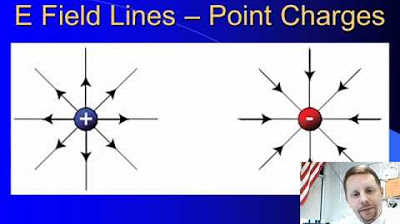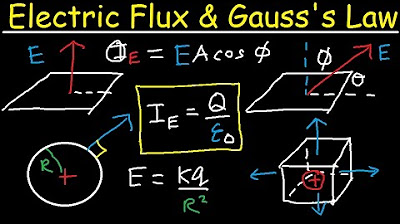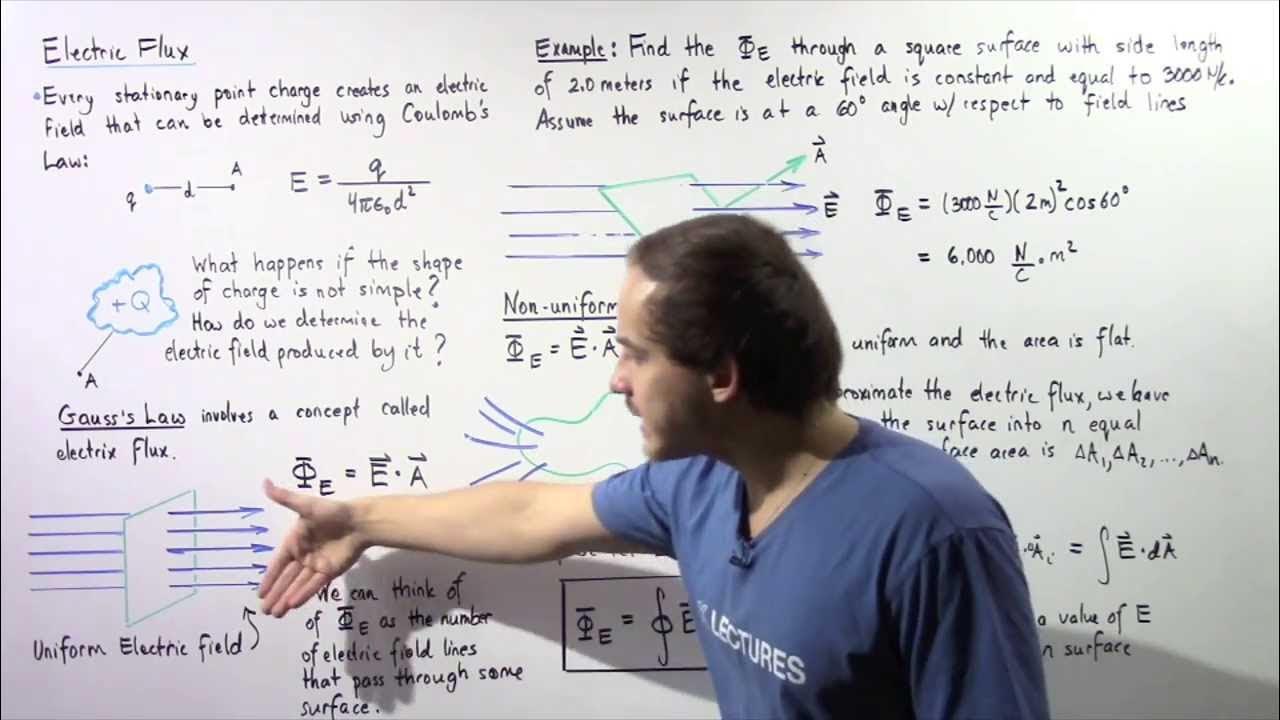Electric Field Due To Point Charges - Physics Problems
TLDRThe video script delves into the concept of electric fields, explaining their calculation using the formula E = F/q. It discusses how electric fields act on positive and negative charges differently and how charges create their own electric fields. The script uses examples of point charges to illustrate how to determine the direction and magnitude of electric fields. It also covers the creation of electric fields by parallel metal plates and presents several word problems to reinforce the concepts learned.
Takeaways
- 📐 The electric field (E) is calculated using the formula E = F/test charge (q), with F in Newtons and q in Coulombs, resulting in units of Newtons per Coulomb (N/C).
- 🚀 The direction of the electric field is influenced by the sign of the charge: positive charges create an electric field in the same direction as the field, while negative charges create an electric field in the opposite direction.
- 🔋 The electric field created by a point charge is radially outward from a positive charge and radially inward towards a negative charge.
- 📈 The magnitude of the electric field from a point charge is given by the equation E = k*Q/r^2, where k is Coulomb's constant, Q is the charge, and r is the distance from the charge.
- 🌐 The electric field is a vector quantity, meaning it has both magnitude and direction.
- 🔄 The electric field at a point can be found by vector addition when multiple charges are present, taking into account the direction and magnitude of each individual field.
- 🔧 The force experienced by a charge in an electric field can be calculated using the equation F = q*E, where F is the force, q is the charge, and E is the electric field.
- 🤹♂️ Positive and negative charges accelerate in opposite directions in an electric field, with positive charges moving in the direction of the field and negative charges moving opposite to it.
- 🔌 The electric field can be visualized with field lines, which start at positive charges and end at negative charges, the density of which indicates the field's strength.
- 🛠️ The electric field can be used to solve for unknown quantities such as charge magnitudes or distances when other variables are known.
- 🧲 Charges can be suspended in an electric field when the electric force equals the gravitational force acting on them, allowing for the calculation of the required mass.
Q & A
What is the definition of an electric field?
-The electric field is defined as the electric force acting on a tiny test charge divided by the magnitude of that test charge. It is measured in newtons per coulomb and is represented as a vector quantity, indicating both magnitude and direction.
How does the direction of the electric field affect positive and negative charges?
-For a positive charge, the electric field and force vectors will be in the same direction, meaning the charge will accelerate in the direction of the electric field. Conversely, for a negative charge, the force will accelerate it in the opposite direction of the electric field.
What is the relationship between the electric field created by a point charge and the distance from the charge?
-The electric field created by a point charge is inversely proportional to the square of the distance from the charge. As you move further away from the charge, the electric field strength decreases, and vice versa.
What is Coulomb's law and how is it used to calculate the force between two charges?
-Coulomb's law states that the force between two charges is directly proportional to the product of the magnitudes of the charges and inversely proportional to the square of the distance between them. The force is calculated using the formula F = k * q1 * q2 / r^2, where F is the force, k is Coulomb's constant, q1 and q2 are the charges, and r is the distance between the charges.
How can you determine the electric field at a point due to multiple charges?
-To determine the electric field at a point due to multiple charges, you calculate the electric field vector at that point due to each charge individually and then add up all the vectors. The resultant electric field is the vector sum of the individual electric fields.
What is the direction of the electric field created by a positive charge and a negative charge?
-The electric field created by a positive charge extends away from the charge in all directions, while the electric field created by a negative charge points towards the charge, extending in all directions towards it.
How can you calculate the electric field at a point a distance away from a charge?
-To calculate the electric field at a point, you use the formula E = k * Q / r^2, where E is the electric field, k is Coulomb's constant, Q is the charge creating the field, and r is the distance from the charge to the point of interest.
What happens to the electric field when the magnitude of a charge is doubled?
-When the magnitude of a charge is doubled, the electric field strength also doubles, assuming the distance from the charge remains constant.
What is the effect of doubling the distance from a charge on the electric field?
-Doubling the distance from a charge to a point results in the electric field strength becoming one-fourth of its original value, due to the inverse square relationship.
How can you find the point between two charges where the net electric field is zero?
-For two identical charges, the net electric field is zero at the midpoint between them. If the charges have different magnitudes, you need to find a point closer to the smaller charge where the electric fields from both charges have the same magnitude but opposite directions, thus canceling each other out.
What is the significance of the electric field direction in relation to the force acting on a charge?
-The direction of the electric field is significant as it indicates the direction in which a positive test charge would be accelerated and the opposite direction for a negative test charge. This helps predict the behavior of charges in the presence of electric fields.
Outlines
📚 Introduction to Electric Fields
This paragraph introduces the concept of electric fields, explaining how they are calculated using the formula E = F/q, where E is the electric field, F is the electric force, and q is the test charge. It emphasizes that electric fields are vectors and discusses how positive and negative charges interact with electric fields, accelerating in the same or opposite direction, respectively. The paragraph also touches on how charges create their own electric fields, with the field extending away from positive charges and towards negative charges.
🔧 Calculating Electric Fields from Point Charges
This section delves into the specifics of calculating the electric field created by a point charge using the equation E = kQ/r^2, where k is Coulomb's constant, Q is the charge, and r is the distance from the charge. The explanation includes a step-by-step process of determining the direction of the electric field and how to visualize it using arrows. It also discusses the concept of a test charge and its minimal impact on the calculation when it is very small.
📈 Solving Word Problems Involving Electric Fields
The paragraph presents a series of word problems that apply the concepts of electric fields to real-world scenarios. It covers how to determine the magnitude and direction of the electric field at various points due to different types of charges. The problems involve calculating the electric field's effect on a negative charge, suspending a positive charge in a uniform electric field, and determining the electric field's magnitude and direction when an electron is accelerated by it.
🌐 Direction of Electric Fields
This part focuses on understanding the direction of electric fields acting on charges. It explains that the direction of the electric field is dependent on the charge of the object—it acts in the direction of the force for positive charges and opposite for negative charges. The paragraph uses a practical example of a negative charge experiencing a force opposite to the direction of the electric field and provides a clear explanation of how to determine the electric field's direction in different situations.
🔬 Experimenting with Charges and Electric Fields
The paragraph discusses an experiment involving two identical charges and their electric fields. It explores the net electric field at various points along the x-axis relative to the charges. The aim is to find the points where the net electric field is zero, considering the charges' magnitudes and their separation distance. The explanation includes the calculation of the electric field at a point where the net field is zero when one charge's magnitude is doubled.
📊 Electric Field Variation with Charge and Distance
This section examines how the electric field changes with variations in the magnitude of the charge and the distance from the charge. It explains the inverse square relationship between the electric field and the distance, highlighting that increasing the charge magnitude or decreasing the distance results in a stronger electric field. The paragraph provides a clear example of how doubling the charge's magnitude or halving the distance affects the electric field's strength.
🤔 Analyzing Electric Fields of Multiple Charges
The paragraph presents a detailed analysis of the electric field due to multiple charges. It discusses the net electric field at a point midway between two charges and how to calculate it using the principle of superposition. The explanation includes determining the direction of the electric field and the impact of the charges' magnitudes and their separation distance on the net electric field. The paragraph also addresses a scenario where the distance between a charge and a point of interest is reduced by a factor, resulting in a significantly stronger electric field.
🧠 Understanding Electric Fields from Positive Charges
This part focuses on the electric field created by a positive charge and its effect on the surrounding space. It explains that the electric field lines extend away from the positive charge and provides a clear example of how to calculate the electric field at a specific point due to a point charge. The paragraph also discusses how the electric field's magnitude can be determined at various locations and how the direction of the field is established based on the charge's sign.
🔄 Interaction of Electric Fields with Electrons
The paragraph discusses the interaction of an electron with an electric field. It explains how an electron, which has a negative charge, will be accelerated in the opposite direction of the electric field due to the force exerted on it. The section provides a detailed example of calculating the electron's acceleration in a given electric field and further explores the final speed of the electron after it has been accelerated.
Mindmap
Keywords
💡Electric Field
💡Charge
💡Coulomb's Law
💡Vector
💡Test Charge
💡Newtons
💡Coulombs
💡Point Charge
💡Acceleration
💡Electric Force
💡Gravitational Force
Highlights
The electric field is defined as the electric force acting on a test charge divided by the magnitude of that test charge, with units of newtons per coulomb.
Electric field is a vector quantity, similar to force, and indicates how the electric force will act on positive or negative charges.
Positive charges accelerate in the same direction as the electric field, while negative charges accelerate in the opposite direction.
Charges create their own electric fields; positive charges create fields extending away from them, while negative charges create fields pointing towards them.
The electric field at a point due to a point charge can be calculated using the formula E = k*Q/r^2, where k is Coulomb's constant, Q is the charge, and r is the distance from the charge.
The direction of the electric field can be determined by drawing an arrow from a positive charge to a point of interest or from a point of interest to a negative charge.
The electric field can exert a force on any type of charge, and the force between two charges can be calculated using Coulomb's law.
The electric field's direction can be described relative to the positive x-axis, such as due south or at an angle of 270 degrees in a counterclockwise direction.
To calculate the magnitude of the electric field, the electric force can be divided by the magnitude of the charge, as demonstrated in the example of a negative charge in a north-directed electric field.
An electric field can suspend a charge in the air if the electric force equals the gravitational force acting on the charge.
The mass of a charge can be calculated if it is suspended in an electric field, using the formula mass = (electric field * charge magnitude) / gravitational acceleration.
An electron's acceleration in an electric field can be used to determine the magnitude and direction of the electric field, as shown in the example of an electron released from rest and accelerating eastward.
The electric field at a point can be calculated using the point charge formula, and the direction can be determined based on the charge's sign and the point's position relative to the charge.
The net electric field at a point can be found by vector addition of the individual electric fields due to multiple charges.
The electric field's magnitude can be increased either by increasing the charge magnitude or by decreasing the distance between the point of interest and the charge.
The direction of the net electric field can be determined by the relative magnitudes and positions of the charges, as illustrated in the example of two identical charges with one having its magnitude doubled.
The net electric field can be zero at a specific point between two charges if the charges are identical, and this point is the midpoint between the charges.
If the magnitudes of two charges are different, the net electric field can still be zero at a point, but this point will be closer to the charge with the smaller magnitude.
The electric field's magnitude and direction can be calculated for multiple points around a charge or system of charges, as demonstrated with the examples of positive and negative charges in various configurations.
Transcripts
Browse More Related Video

High School Physics - Electric Fields

How To Draw Electric Field Lines of Point Charges - College Physics

Electric Field, Force, Potential, Potential Energy (AP Physics SuperCram Review)

Electric Flux, Gauss's Law & Electric Fields, Through a Cube, Sphere, & Disk, Physics Problems

What is the Electric Field? How do Electric Forces Work?

Electric Flux
5.0 / 5 (0 votes)
Thanks for rating: